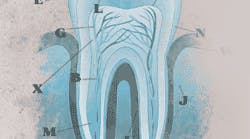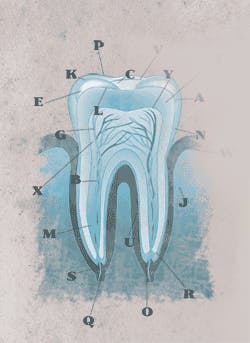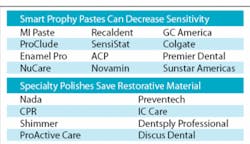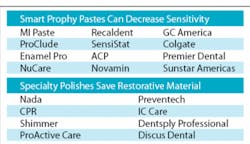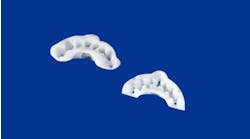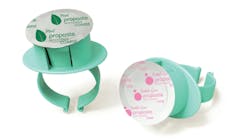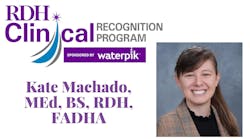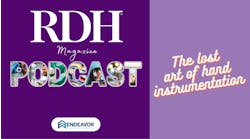Polishing Enamel—PART 7 of 10
by Shirley Gutkowski, RDH
In the world of minimal intervention, the dental hygienist's friend, prophy paste, may actually be the enemy. Saving enamel and causing the least amount of damage during dental procedures is at the core. At first glance, polishing paste doesn't seem harmful. Dental hygienists polish teeth every day and never think twice about it. But polishing paste, with its spinning bits of lava rock, does damage the enamel (see “Whether They Need it or Not," RDH magazine, November 2001).
Healthy enamel is quite visibly damaged by prophy paste. The coarser the paste, the more damage that occurs, and yet all manufacturers of prophy paste report that coarse is the biggest seller. When offering samples, they offer coarse because they need it to be competitive with what the customer uses daily. However, we now have so many other options on polishing paste, enabling us to do much more for our patients' enamel health.
Air polishing doesn't get much publicity, yet it is the most versatile of all polishes. It is a necessary component of advanced enamel lesion detection and sealant placement. Failing to prepare the tooth with an air polish before using a DIAGNOdent could lead to a false reading. Preparing the tooth for a sealant with a prophy brush and regular paste, or even paste without additives such as fluoride or flavoring oils, places the tooth at high risk for a sealant bomb. There can be nothing on the tooth before placing a sealant. The organic plug must be removed as it is a packed house of caries pathogens that will continue to break down the enamel.
There are two main types of air polishing powder. One is the traditional sodium bicarbonate, and the other is calcium carbonate. Mint is often added to make it a little more palatable. When using the sodium bicarb, the angle of the tip is at 90 degrees to the tooth, allowing the powder to hammer off the stain. While this is violent, it does not remove as much enamel as pumice. Setting the powder knob to very low powder and very high water gives great results for the majority of patients.
The calcium carbonate powder, ProphyPearls, uses microsphere technology to remove stain. Using an angle between 40 and 60 degrees, the spheres roll the stain off the teeth. This also helps decrease the damage to the sulcus. Using the 90-degree angle in pits and fissures blasts out or obliterates the organic plug, helping sealant retention.
Pumice polishing pastes have no therapeutic value to enamel at all. Offering it as an option to your patients instead of automatically doing it as the finishing touch to a prophy is better for their enamel. Polishing before the prophy is also worth considering. This can lower the bacteria in the created aerosols and create even more damage to enamel affected by a thick biofilm coating.
On the other hand, use of a therapeutic polish can diminish sensitivity and help restorations last longer. Not many clinicians think of the open margins of esthetic restorations as being caused by improper polishing paste. The damage is so minute that even wearing loupes won't help until stain starts to gather. Polishes made for esthetic restorations use a different abrasive that isn't as damaging to the expensive materials as pumice.
Therapeutic polishing pastes, or smart pastes, contain a variety of ingredients that do a number of things, most notably decrease sensitivity. People who have trouble with ultrasonic scaling can have a very comfortable appointment after a polish with one of the sensitivity polishes. Cold water may also be more comfortable for people if they are polished with one of the smart pastes listed in the box.
A regular toothpaste is often in order for polishing. Its low abrasiveness is better for the enamel, although it's a challenge for clinicians to use because it spatters. Even some of the advanced or smart prophy pastes can act in a hostile manner toward the most well-meaning hygienist.
Choosing the right prophy cup is useful here. Hard cups do more damage to enamel than soft, and the faster the spin the more damage that occurs. Most dental hygienists know this innately, and press the rheostat to RPM in the red zone when patients have tough stain.
This, of course, is very detrimental to the enamel. One of the problems with reviewing the research on the damage done by polishing pastes is that all the studies are done with different speeds, different cup flexibility, and different webbing. These inconsistencies make it impossible to formulate a PICO question that delivers meaningful results. The short answer is that the faster, the more webbing, and the stiffer the cup, the more damage to the enamel and dentin when using traditional paste.
Many cups are also made of latex, which creates a potential problem for those who suffer from latex allergy. To do the least damage and best job, choose wisely. A flexible cup at slow speeds with some webbing is the best option.
Back to the soft prophy paste options — there is a new cup design that keeps the pastes from splattering. The Elite prophy cup is made by Young and has webbing on the outside that keeps the saliva clump on the tooth.
Since the goal of polishing is to remove stain, really think about who needs to have their teeth polished. If stain is present, make a choice for the right kind of polish for the presentation and possibly remove it with an ultrasonic scaler. One size polishing paste does not fit all.
In this series of articles, I'm trying to bring you the new science, the new products, and how and when to use them. I encourage you to put this series into a binder to keep on hand, and add to it. As these articles go to press two months after they're submitted, lots of things change. Contact me if you think I've missed something, or just add it to the information here. Keep the MI philosophy in mind.
About the Author
Shirley Gutkowski, RDH, BSDH, FACE, is co-director of CareerFusion and a practicing dental hygienist. She is co-author of the bestselling book, The Purple Guide: Developing Your Clinical Dental Hygiene Career with Amy Nieves, RDH. She can be contacted at [email protected].
